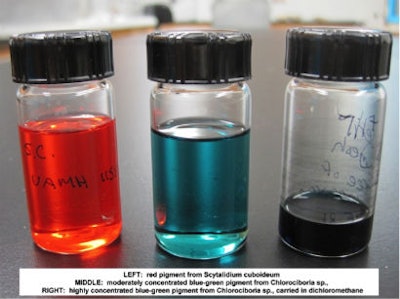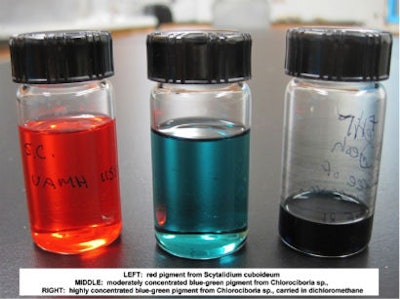

Fungus is fun, and spalting is beautiful and fascinating. In fact, I now have a PhD and a post doc, all focused on spalting.
I started by looking at zone lines that developed in green wood, but as my research progressed and it was proven that spalting could be readily induced even in kiln dried lumber, interest from industry increased and continual pilot projects were funded. About mid-way through my post doc I left zone lines behind in favor of developing the far less appreciated pigments associated with spalting, and it was at this point that the researched started moving in a whole different direction.
Such as?
Pigment-type spalting is the kind that causes wide swatches of color on wood (blue-green, red, yellow, etc). This is the most prominent form of spalting in traditional European woodwork and was the dominant form of spalting in wood art and craft for hundreds of years (think wood intarsia and marquetry of the 15th and 16th centuries). Most popular was the blue-green wood colored by Chlorociboria species through the pigment xylindein (an extracellular pigment produced by the fungus into the wood).
By focusing my research on fungi that produced pigments in wood instead of on wood, or pigments that were obtained from fruiting bodies themselves, I accidentally stumbled into a group of colorants with amazing properties. Because these pigments were meant to persist for years in rain, sun, and against other fungi, they were naturally durable on wood. The amazing color stability of xylindein can be seen on any of the historic intarsias of Europe, where the blue-green color is often the only color remaining, as the synthetic colorants have faded over time.
So were old artists actually putting mold on wood? Is that what you’re proposing?
No. People did not have any real concept of microorganisms for much of antiquity, so the colored wood was thought to be a naturally occurring wood variant. It was specifically sought out and collected, and also sold at a price premium. Spalted wood shows up in wood xyloteques from the 1800s as well.
This is an old science in many ways. In the late 1800s and early 1900s, scientists conducted experiments on xylindein in terms of extraction and its potential uses, and by following these protocols I was able to successfully extract not only xylindein, but pigments from other spalting fungi as well.
At first my goal was small. I really just wanted a faster method of coloring wood without waiting for fungi to grow. And the pigments definitely achieved that. What once took months to years could suddenly be done in hours. But the unique nature of these pigments meant that they had potential uses as dyes for numerous products, and experimentation had to begin somewhere.
So what do we do with this?
Because spalting is so visual, we have artists, microbiologists, botanists, designers, and chemists all working together toward common goals.
Our first non-wood trials started with textiles, a project executed by my master's student Eric Hinsch. The fungal pigments turned out to be more stable, even through washing, bleaching, UV, and sweat testing than any of the other common natural textile dyes we tested.
 Pigments used as dyes.
Pigments used as dyes.
So can I expect to buy a T-shirt with a fungus dye in the near future?
I hope so. Truth be told, I was completely unprepared for the almost universal success of these pigments as broad-spectrum colorants. But now, after over 10 years of research, I find myself with an outstanding new, natural set of colorants. I also have companies asking to sell products made with the pigments, but my lab does not have the desire nor the capacity to produce these products ourselves. I am starting talks with some finishing companies, wood or other paint or stain producers, but I am not sure yet where we’ll end up. We need to find the right company to work with—to go in on patents, distribute the pigment dyes, and bring spalting into mainstream society.
Mainstream Mold, who would have thought? OK, we’ll wrap this up next week with some discussions of particular spaltings of interest….
Editor's Note: This is part two of a series. Read part one here.
































